Copernicus Sentinel-3 OLCI Level-1B Radiometry Product Validation Status After Six Years in Constellation by Three Independent Expert Groups
Abstract
1. Introduction
2. Materials and Methods
2.1. OLCI Overview
- The five cameras are configured in a fan shape across the FOV in the vertical plane perpendicular to the platform velocity.
- Each individual camera’s 14.2° FOV has a 0.6° overlap with neighboring camera modules.
- To minimize the impact of sunglint, the FOV of the whole array is shifted across-track by 12.58°, away from the sun.
2.2. Level-1B Product Overview
2.3. Absolute Radiometry Vicarious Validation
2.3.1. Pseudo-Invariant Calibration Site over Desert
2.3.2. Rayleigh Scattering Vicarious Calibration over Ocean Surface

2.3.3. Inter-Band Vicarious Calibration over Sunglint
2.4. Software and Databases
2.4.1. DIMITRI Software and Database (ESA, ESTEC, Noordwijk, the Netherlands)
DIMITRI Pseudo-Invariant Calibration Site over Desert
DIMITRI Rayleigh Scattering Vicarious Calibration over Ocean Surface
DIMITRI Inter-Band Vicarious Calibration over Sunglint
2.4.2. OSCAR Software (VITO, Mol, Belgium)
OSCAR Rayleigh Scattering Vicarious Calibration over Ocean Surface
OSCAR Inter-Band Vicarious Calibration over Sunglint
2.4.3. SADE/MUSCLE System (CNES, Toulouse, France)
SADE/MUSCLE Pseudo-Invariant Calibration Site over Desert
SADE/MUSCLE Rayleigh Scattering Vicarious Calibration over Ocean Surface
SADE/MUSCLE Inter-Band Vicarious Calibration over Sunglint
3. Results
3.1. Pseudo-Invariant Calibration Site over Desert Results
3.2. Rayleigh Scattering Vicarious Calibration over Ocean Surface Results
3.3. Inter-Band Vicarious Calibration over Sunglint Results
3.4. OLCI-A and OLCI-B Intercalibration and Result Synthesis
4. Discussion
4.1. PICS over Desert Results
4.2. Rayleigh Scattering over Ocean Results
4.3. Sunglint over Ocean Results
4.4. OLCI-A and OLCI-B Intercalibration Results
5. Conclusions and Perspectives
Author Contributions
Funding
Data Availability Statement
Acknowledgments
Conflicts of Interest
Appendix A

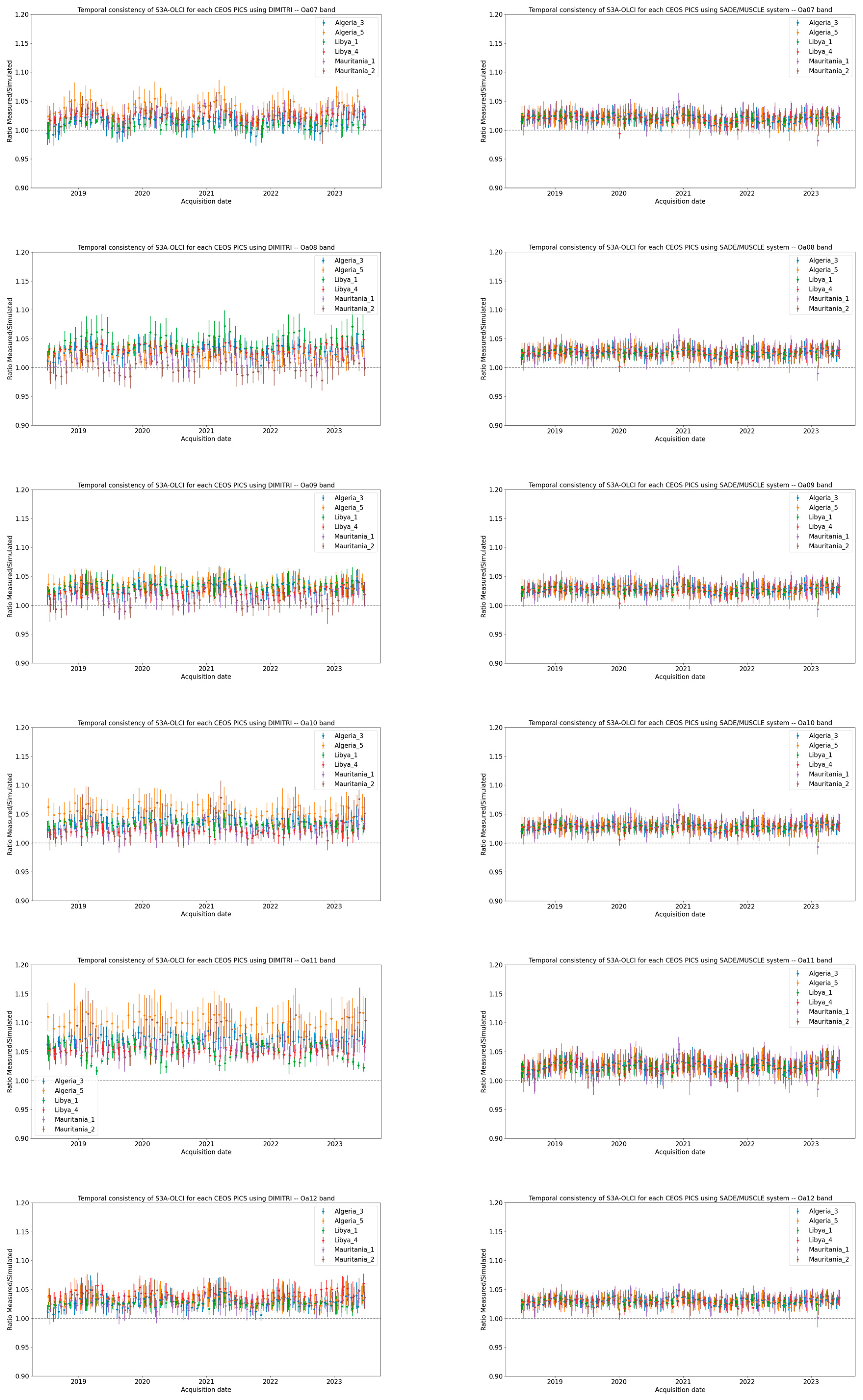
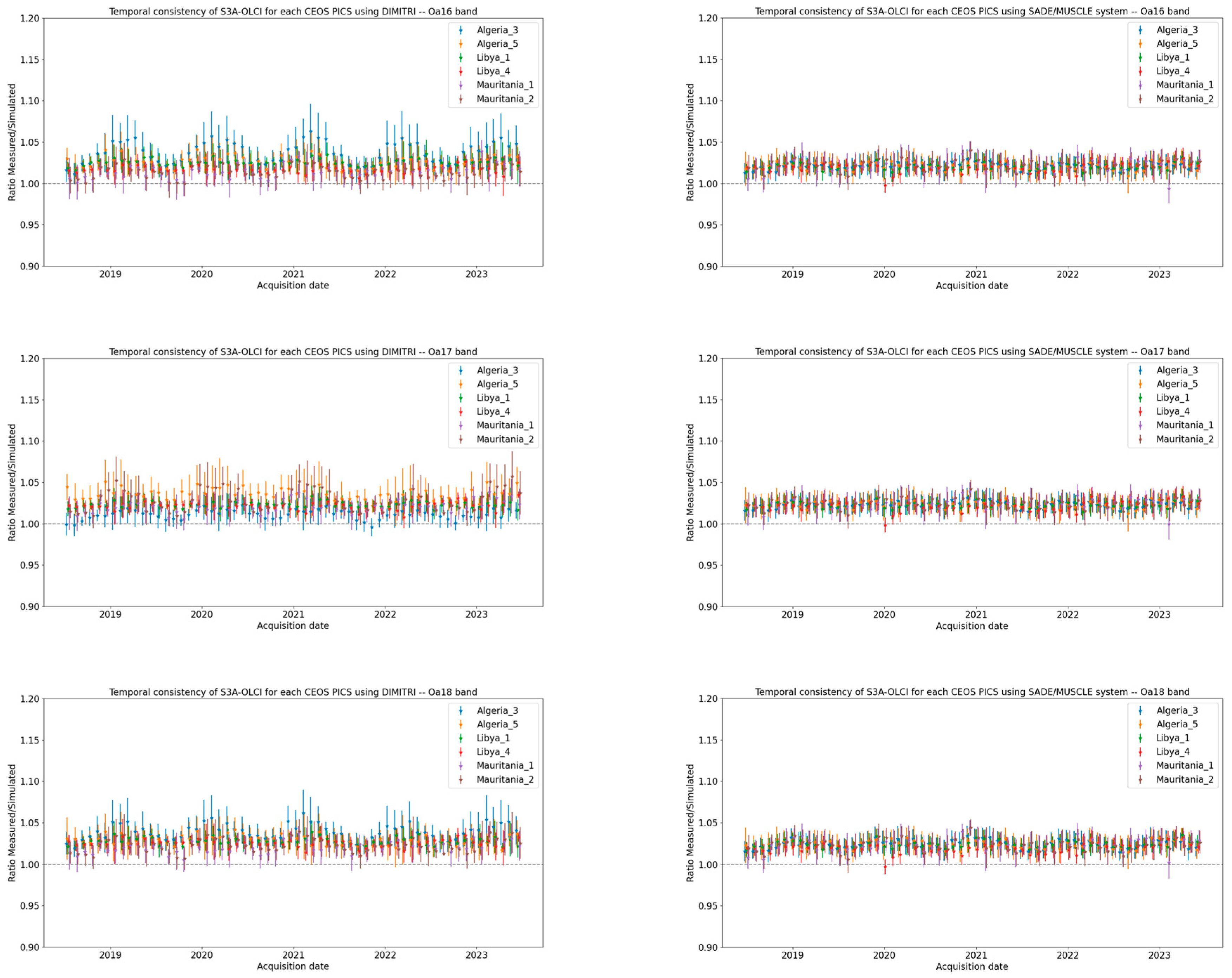
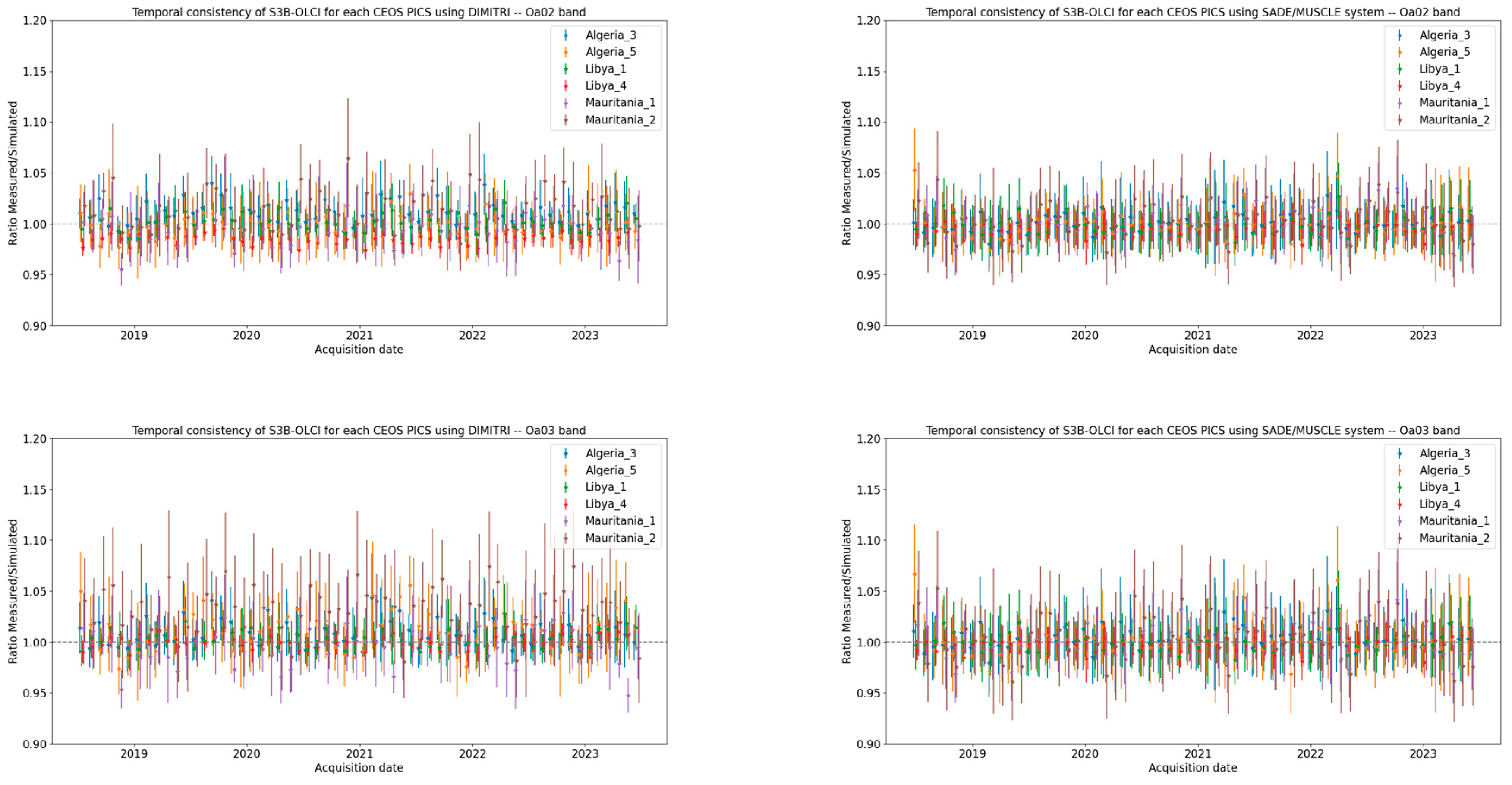


References
- Donlon, C.; Berruti, B.; Buongiorno, A.; Ferreira, M.-H.; Féménias, P.; Frerick, J.; Goryl, P.; Klein, U.; Laur, H.; Mavrocordatos, C.; et al. The Global Monitoring for Environment and Security (GMES) Sentinel-3 Mission. Remote Sens. Environ. 2012, 120, 37–57. [Google Scholar] [CrossRef]
- Lamquin, N.; Bourg, L.; Clerc, S.; Donlon, C. OLCI A/B Tandem Phase Analysis, Part 3: Post-Tandem Monitoring of Cross-Calibration from Statistics of Deep Convective Clouds Observations. Remote Sens. 2020, 12, 3105. [Google Scholar] [CrossRef]
- Lamquin, N.; Clerc, S.; Bourg, L.; Donlon, C. OLCI A/B Tandem Phase Analysis, Part 1: Level 1 Homogenisation and Harmonisation. Remote Sens. 2020, 12, 1804. [Google Scholar] [CrossRef]
- Clerc, S.; Donlon, C.; Borde, F.; Lamquin, N.; Hunt, S.E.; Smith, D.; McMillan, M.; Mittaz, J.; Woolliams, E.; Hammond, M.; et al. Benefits and Lessons Learned from the Sentinel-3 Tandem Phase. Remote Sens. 2020, 12, 2668. [Google Scholar] [CrossRef]
- Lamquin, N.; Woolliams, E.; Bruniquel, V.; Gascon, F.; Gorroño, J.; Govaerts, Y.; Leroy, V.; Lonjou, V.; Alhammoud, B.; Barsi, J.A.; et al. An Inter-Comparison Exercise of Sentinel-2 Radiometric Validations Assessed by Independent Expert Groups. Remote Sens. Environ. 2019, 233, 111369. [Google Scholar] [CrossRef]
- Bourg, L.; Bruniquel, J.; Henocq, C.; Morris, H.; Dash, J.; Preusker, R.; Dransfeld, S. Copernicus Sentinel-3 OLCI Land User Handbook; European Space Agen: Paris, France; European Commission: Brussels, Belgium, 2023. [Google Scholar]
- Bourg, L.; Pflug, B.; Bachmann, M.; Malle, M.; Gobron, N. Copernicus Cal/Val Solution—D1.1—Optical Missions Cal/Val Requirements; European Commission: Brussels, Belgium, 2021. [Google Scholar]
- Fougnie, B. S3ETRAC Preprocessing and Extraction Specification of the Sentinel-3 Extraction Tool for Radiometric Analysis and Calibration (ATBD) 2014; European Space Agen: Paris, France, 2014. [Google Scholar]
- Holben, B.N.; Kaufman, Y.J.; Kendall, J.D. NOAA-11 AVHRR Visible and near-IR Inflight Calibration. Int. J. Remote Sens. 1990, 11, 1511–1519. [Google Scholar] [CrossRef]
- Govaerts, Y.M.; Clerici, M. Evaluation of Radiative Transfer Simulations over Bright Desert Calibration Sites. IEEE Trans. Geosci. Remote Sens. 2004, 42, 176–187. [Google Scholar] [CrossRef]
- Slater, P.N.; Biggar, S.F.; Holm, R.G.; Jackson, R.D.; Mao, Y.; Moran, M.S.; Palmer, J.M.; Yuan, B. Reflectance- and Radiance-Based Methods for the in-Flight Absolute Calibration of Multispectral Sensors. Remote Sens. Environ. 1987, 22, 11–37. [Google Scholar] [CrossRef]
- Lacherade, S.; Fougnie, B.; Henry, P.; Gamet, P. Cross Calibration Over Desert Sites: Description, Methodology, and Operational Implementation. IEEE Trans. Geosci. Remote Sens. 2013, 51, 1098–1113. [Google Scholar] [CrossRef]
- Bouvet, M. Radiometric Comparison of Multispectral Imagers over a Pseudo-Invariant Calibration Site Using a Reference Radiometric Model. Remote Sens. Environ. 2014, 140, 141–154. [Google Scholar] [CrossRef]
- Cosnefroy, H.; Leroy, M.; Briottet, X. Selection and Characterization of Saharan and Arabian Desert Sites for the Calibration of Optical Satellite Sensors. Remote Sens. Environ. 1996, 58, 101–114. [Google Scholar] [CrossRef]
- Bacour, C.; Briottet, X.; Bréon, F.-M.; Viallefont-Robinet, F.; Bouvet, M. Revisiting Pseudo Invariant Calibration Sites (PICS) Over Sand Deserts for Vicarious Calibration of Optical Imagers at 20 Km and 100 Km Scales. Remote Sens. 2019, 11, 1166. [Google Scholar] [CrossRef]
- Shrestha, M.; Leigh, L.; Helder, D. Classification of North Africa for Use as an Extended Pseudo Invariant Calibration Sites (EPICS) for Radiometric Calibration and Stability Monitoring of Optical Satellite Sensors. Remote Sens. 2019, 11, 875. [Google Scholar] [CrossRef]
- Kabir, S.; Leigh, L.; Helder, D. Vicarious Methodologies to Assess and Improve the Quality of the Optical Remote Sensing Images: A Critical Review. Remote Sens. 2020, 12, 4029. [Google Scholar] [CrossRef]
- Gordon, H.R.; Wang, M. Retrieval of Water-Leaving Radiance and Aerosol Optical Thickness over the Oceans with SeaWiFS: A Preliminary Algorithm. Appl. Opt. 1994, 33, 443–452. [Google Scholar] [CrossRef] [PubMed]
- Morel, A. Optical Modeling of the Upper Ocean in Relation to Its Biogenous Matter Content (Case I Waters). J. Geophys. Res. Oceans 1988, 93, 10749–10768. [Google Scholar] [CrossRef]
- Morel, A.; Prieur, L. Analysis of Variations in Ocean Color. Limnol. Oceanogr. 1977, 22, 709–722. [Google Scholar] [CrossRef]
- Shettle, E.; Fenn, R. Models for the Aerosols of the Lower Atmosphere and the Effects of Humidity Variations on Their Optical Properties. Environ. Res. Pap. 1979, 676, 94. [Google Scholar]
- VERMOTE, E.; SANTER, R.; DESCHAMPS, P.Y.; HERMAN, M. In-Flight Calibration of Large Field of View Sensors at Short Wavelengths Using Rayleigh Scattering. Int. J. Remote Sens. 1992, 13, 3409–3429. [Google Scholar] [CrossRef]
- VERMOTE, E.; KAUFMAN, Y.J. Absolute Calibration of AVHRR Visible and Near-Infrared Channels Using Ocean and Cloud Views. Int. J. Remote Sens. 1995, 16, 2317–2340. [Google Scholar] [CrossRef]
- Moulin, F.; Bernard, D.; Amiranoff, F. Photon-Photon Elastic Scattering in the Visible Domain. Z. Für Phys. C Part. Fields 1996, 72, 607–611. [Google Scholar] [CrossRef]
- Hagolle, O.; Cabot, F. Absolute Calibration of MERIS Using Natural Targets. In Proceedings of the Working Meeting on MERIS and AATSR Calibration and Geophysical Validation, Frascati, Italy, 20–24 October 2003; pp. 20–24. [Google Scholar]
- Meygret, A.; Briottet, X.; Henry, P.J.; Hagolle, O. Calibration of SPOT4 HRVIR and Vegetation Cameras over Rayleigh Scattering. In Proceedings of the Earth Observing Systems V, San Diego, CA, USA, 22 July–4 August 2000; Barnes, W.L., Ed.; SPIE: Bellingham, WA, USA, 2000; p. 302. [Google Scholar]
- Bruniquel, V.; e Fontanilles, G.; Bourg, L.; Fougnie, B.; Henry, P. Absolute Calibration of SeaWiFS Using Rayleigh Scattering. In Proceedings of the International Ocean Colour Science Meeting, Baltimore, MD, USA, 13–15 May 2013; Volume 43. [Google Scholar]
- Fougnie, B.; Desjardins, C.; Besson, B.; Bruniquel, V.; Meskini, N.; Nieke, J.; Bouvet, M. Results from the Radiometric Validation of Sentinel-3 Optical Sensors Using Natural Targets. In Proceedings of the Earth Observing Systems XXI, San Diego, CA, USA, 28 August–1 September 2016; Butler, J.J., Xiong, X., Gu, X., Eds.; SPIE: Bellingham, WA, USA, 2016; p. 99720O. [Google Scholar]
- Fougnie, B.; Bracco, G.; Lafrance, B.; Ruffel, C.; Hagolle, O.; Tinel, C. PARASOL In-Flight Calibration and Performance. Appl. Opt. 2007, 46, 5435. [Google Scholar] [CrossRef] [PubMed]
- Sterckx, S.; Livens, S.; Adriaensen, S. Rayleigh, Deep Convective Clouds, and Cross-Sensor Desert Vicarious Calibration Validation for the PROBA-V Mission. IEEE Trans. Geosci. Remote Sens. 2013, 51, 1437–1452. [Google Scholar] [CrossRef]
- Alhammoud, B.; Jackson, J.; Clerc, S.; Arias, M.; Bouzinac, C.; Gascon, F.; Cadau, E.G.; Iannone, R.Q.; Boccia, V. Sentinel-2 Level-1 Radiometry Assessment Using Vicarious Methods From DIMITRI Toolbox and Field Measurements From RadCalNet Database. IEEE J. Sel. Top. Appl. Earth Obs. Remote Sens. 2019, 12, 3470–3479. [Google Scholar] [CrossRef]
- Revel, C.; Lonjou, V.; Marcq, S.; Desjardins, C.; Fougnie, B.; Coppolani-Delle Luche, C.; Guilleminot, N.; Lacamp, A.-S.; Lourme, E.; Miquel, C.; et al. Sentinel-2A and 2B Absolute Calibration Monitoring. Eur. J. Remote Sens. 2019, 52, 122–137. [Google Scholar] [CrossRef]
- Kaufman, Y.J.; Holben, B.N. Calibration of the AVHRR Visible and Near-IR Bands by Atmospheric Scattering, Ocean Glint and Desert Reflection. Int. J. Remote Sens. 1993, 14, 21–52. [Google Scholar] [CrossRef]
- Cox, C.; Munk, W. Statistics of the Sea Surface Derived from Sun Glitter. J. Mar. Res. 1954, 13. Available online: https://elischolar.library.yale.edu/cgi/viewcontent.cgi?article=1813&context=journal_of_marine_research (accessed on 20 March 2025).
- Hagolle, O.; Goloub, P.; Deschamps, P.-Y.; Cosnefroy, H.; Briottet, X.; Bailleul, T.; Nicolas, J.-M.; Parol, F.; Lafrance, B.; Herman, M. Results of POLDER In-Flight Calibration. IEEE Trans. Geosci. Remote Sens. 1999, 37, 1550–1566. [Google Scholar] [CrossRef]
- Hochberg, E.J.; Andrefouet, S.; Tyler, M.R. Sea Surface Correction of High Spatial Resolution Ikonos Images to Improve Bottom Mapping in Near-Shore Environments. IEEE Trans. Geosci. Remote Sens. 2003, 41, 1724–1729. [Google Scholar] [CrossRef]
- Morel, A.; Maritorena, S. Bio-Optical Properties of Oceanic Waters: A Reappraisal. J. Geophys. Res. Oceans 2001, 106, 7163–7180. [Google Scholar] [CrossRef]
- Alhammoud, B.; Bouvet, M. DIMITRI V4 Algorithm Theoretical Basis Document: Sensor-to-Simulation Intercomparison over Desert Pseudo-Invariant Calibration Sites (PICS) 2023; European Space Agen: Paris, France, 2023. [Google Scholar]
- Morel, A.; Gentili, B. Diffuse Reflectance of Oceanic Waters. III. Implication of Bidirectionality for the Remote-Sensing Problem. Appl. Opt. 1996, 35, 4850–4862. [Google Scholar] [CrossRef] [PubMed]
- Fougnie, B.; Henry, P.; Morel, A.; Antoine, D.; Montagner, F. Identification And Characterization of Stable Homogeneous Oceanic Zones: Climatology and Impact on In-Flight Calibration of Space Sensors over Rayleigh Scattering. In Proceedings of the Ocean Optics XVI, Santa Fe, NM, USA, 18–22 November 2002. [Google Scholar]
- Bouvet, M. Selection of Optimum Oceanic Sites for Applying the Rayleigh Scattering Methodology to Optical Space Sensors 2013; European Space Agen: Paris, France, 2013. [Google Scholar]
- Alhammoud, B.; Hedley, J. DIMITRI_v4.x ATBD Rayleigh Scattering Methodology for Vicarious Calibration 2019; European Space Agen: Paris, France, 2019. [Google Scholar]
- Hagolle, O.; Nicolas, J.-M.; Fougnie, B.; Cabot, F.; Henry, P. Absolute Calibration of VEGETATION Derived from an Interband Method Based on the Sun Glint over Ocean. IEEE Trans. Geosci. Remote Sens. 2004, 42, 1472–1481. [Google Scholar] [CrossRef]
- Alhammoud, B.; Hedley, J. DIMITRI_v4.x ATBD Interband Vicarious Calibration over Sunglint 2019; European Space Agen: Paris, France, 2019. [Google Scholar]
- Sterckx, S.; Adriaensen, S.; Dierckx, W.; Bouvet, M. In-Orbit Radiometric Calibration and Stability Monitoring of the PROBA-V Instrument. Remote Sens. 2016, 8, 546. [Google Scholar] [CrossRef]
- Kotchenova, S.Y.; Vermote, E.F.; Matarrese, R.; Frank, J.; Klemm, J. Validation of a Vector Version of the 6S Radiative Transfer Code for Atmospheric Correction of Satellite Data. Part I: Path Radiance. Appl. Opt. 2006, 45, 6762–6774. [Google Scholar] [CrossRef] [PubMed]
- Fougnie, B.; Bach, R. Monitoring of Radiometric Sensitivity Changes of Space Sensors Using Deep Convective Clouds: Operational Application to PARASOL. IEEE Trans. Geosci. Remote Sens. 2009, 47, 851–861. [Google Scholar] [CrossRef]
- Meygret, A.; Blanchet, G.; Colzy, S.; Gross-Colzy, L. Improving ROLO Lunar Albedo Model Using PLEIADES-HR Satellites Extra-Terrestrial Observations. In Proceedings of the Earth Observing Systems XXII, San Diego, CA, USA, 6–10 August 2017; SPIE: Bellingham, WA, USA, 2017; Volume 10402, pp. 702–713. [Google Scholar]
- Meygret, A.; Blanchet, G.; Mounier, F.; Buil, C. The Stars: An Absolute Radiometric Reference for the on-Orbit Calibration of PLEIADES-HR Satellites. In Proceedings of the Earth Observing Systems XXII, San Diego, CA, USA, 6–10 August 2017; SPIE: Bellingham, WA, USA, 2017; Volume 10402, pp. 678–685. [Google Scholar]
- Cabot, F. Proposal for the Development of a Repository for In-Flight Calibration of Optical Sensors over Terrestrial Targets. In Proceedings of the Earth Observing Systems II, San Diego, CA, USA, 28–29 July 1997; SPIE: Bellingham, WA, USA, 1997; Volume 3117, pp. 148–155. [Google Scholar]
- Cabot, F.; Hagolle, O.; Ruffel, C.; Henry, P.J. Remote Sensing Data Respository for In-Flight Calibration of Optical Sensors over Terrestrial Targets. In Proceedings of the Earth Observing Systems IV, San Diego, CA, USA, 18–20 July 1999; SPIE: Bellingham, WA, USA, 1999; Volume 3750, pp. 514–523. [Google Scholar]
- Cabot, F.; Hagolle, O.; Henry, P. Relative and Multitemporal Calibration of AVHRR, SeaWiFS, and VEGETATION Using POLDER Characterization of Desert Sites. In Proceedings of the IEEE 2000 International Geoscience and Remote Sensing Symposium (IGARSS 2000), Honolulu, HI, USA, 24–28 July 2000; Taking the Pulse of the Planet: The Role of Remote Sensing in Managing the Environment. Proceedings (Cat. No.00CH37120). Institute of Electrical and Electronics Engineers Press: New York, NY, USA; Volume 5, pp. 2188–2190. [Google Scholar]
- Cosnefroy, H.; Soule, P.; Briottet, X.; Hagolle, O.; Cabot, F. POLDER Multiangular Calibration Using Desert Sites: Method and Performances. In Proceedings of the Sensors, Systems, and Next-Generation Satellites, Barcelona, Spain, 22–25 September 1997; SPIE: Bellingham, WA, USA, 1997; Volume 3221, pp. 141–148. [Google Scholar]
- Dinguirard, M.C.; Henry, P.J.; Bodilis, M. SPOT Multitemporal Calibration over Stable Desert Areas. In Proceedings of the Recent Advances in Sensors, Radiometric Calibration, and Processing of Remotely Sensed Data, Orlando, FL, USA, 14–16 April 1993; SPIE: Bellingham, WA, USA, 1993; p. 9. [Google Scholar]
- Meygret, A. Absolute Calibration: From SPOT1 to SPOT5. In Proceedings of the Earth Observing Systems X, San Diego, CA, USA, 1 January 2005; SPIE: Bellingham, WA, USA, 2005; Volume 5882, pp. 335–346. [Google Scholar]
- Rahman, H.; Dedieu, G. SMAC: A Simplified Method for the Atmospheric Correction of Satellite Measurements in the Solar Spectrum. Int. J. Remote Sens. 1994, 15, 123–143. [Google Scholar] [CrossRef]
- Lenoble, J.; Herman, M.; Deuzé, J.L.; Lafrance, B.; Santer, R.; Tanré, D. A Successive Order of Scattering Code for Solving the Vector Equation of Transfer in the Earth’s Atmosphere with Aerosols. J. Quant. Spectrosc. Radiat. Transf. 2007, 107, 479–507. [Google Scholar] [CrossRef]
- Fougnie, B.; Llido, J.; Gross-Colzy, L.; Henry, P.; Blumstein, D. Climatology of Oceanic Zones Suitable for In-Flight Calibration of Space Sensors. In Proceedings of the Earth Observing Systems XV, San Diego, CA, USA, 2–5 August 2010; SPIE: Bellingham, WA, USA, 2010; Volume 7807, pp. 215–225. [Google Scholar]
- Fougnie, B. Improvement of the PARASOL Radiometric In-Flight Calibration Based on Synergy Between Various Methods Using Natural Targets. IEEE Trans. Geosci. Remote Sens. 2016, 54, 2140–2152. [Google Scholar] [CrossRef]
- Lebègue, L.; Greslou, D.; Blanchet, G.; de Lussy, F.; Fourest, S.; Martin, V.; Latry, C.; Kubik, P.; Delvit, J.-M.; Dechoz, C.; et al. PLEIADES Satellites Image Quality Commissioning. In Proceedings of the Earth Observing Systems XVIII, San Diego, CA, USA, 26–29 August 2013; SPIE: Bellingham, WA, USA, 2013; Volume 8866, pp. 292–303. [Google Scholar]
- Toubbe, B.; Bailleul, T.; Deuze, J.L.; Goloub, P.; Hagolle, O.; Herman, M. In-Flight Calibration of the POLDER Polarized Channels Using the Sun’s Glitter. IEEE Trans. Geosci. Remote Sens. 1999, 37, 513–524. [Google Scholar] [CrossRef]
- BIPM; IEC; IFCC; ILAC; ISO; IUPAC; IUPAP; OIML. Evaluation of Measurement Data—Guide to the Expression of Uncertainty in Measurement, JCGM, 100 (2008), 1st ed.; Joint Committee for Guides in Metrology: Paris, France, 2008. [Google Scholar]
- Alhammoud, B.; Allen, B.; Bourg, L.; Garnesson, P.; Dransfeld, S.; Kwiatkowska, E. Sentinel-3 Level-1 and Level-2 Products Assessment at the End of the Tandem Phase: Intercomparison with MODIS and VIIRS Products. In Proceedings of the Living Planet Symposium 2019, Milan, Italy, 13–17 May 2019. [Google Scholar]
- Wang, Z.; Zeng, Q.; Qiu, S.; Wang, C.; Sun, T.; Du, J. Assessing the Quality of Chlorophyll-a Concentration Products under Multiple Spatial and Temporal Scales. Front. Earth Sci. 2024, 18, 463–487. [Google Scholar] [CrossRef]
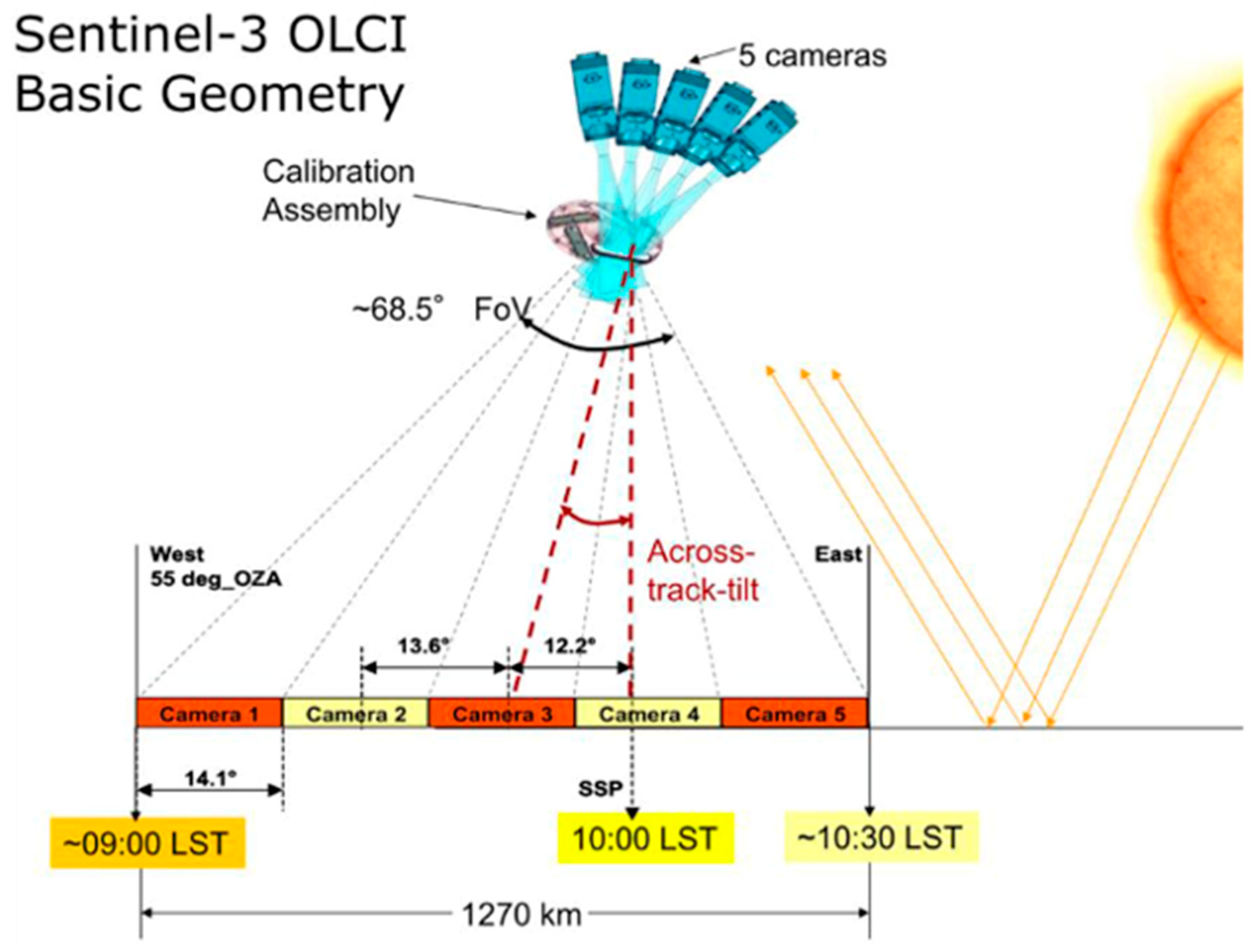
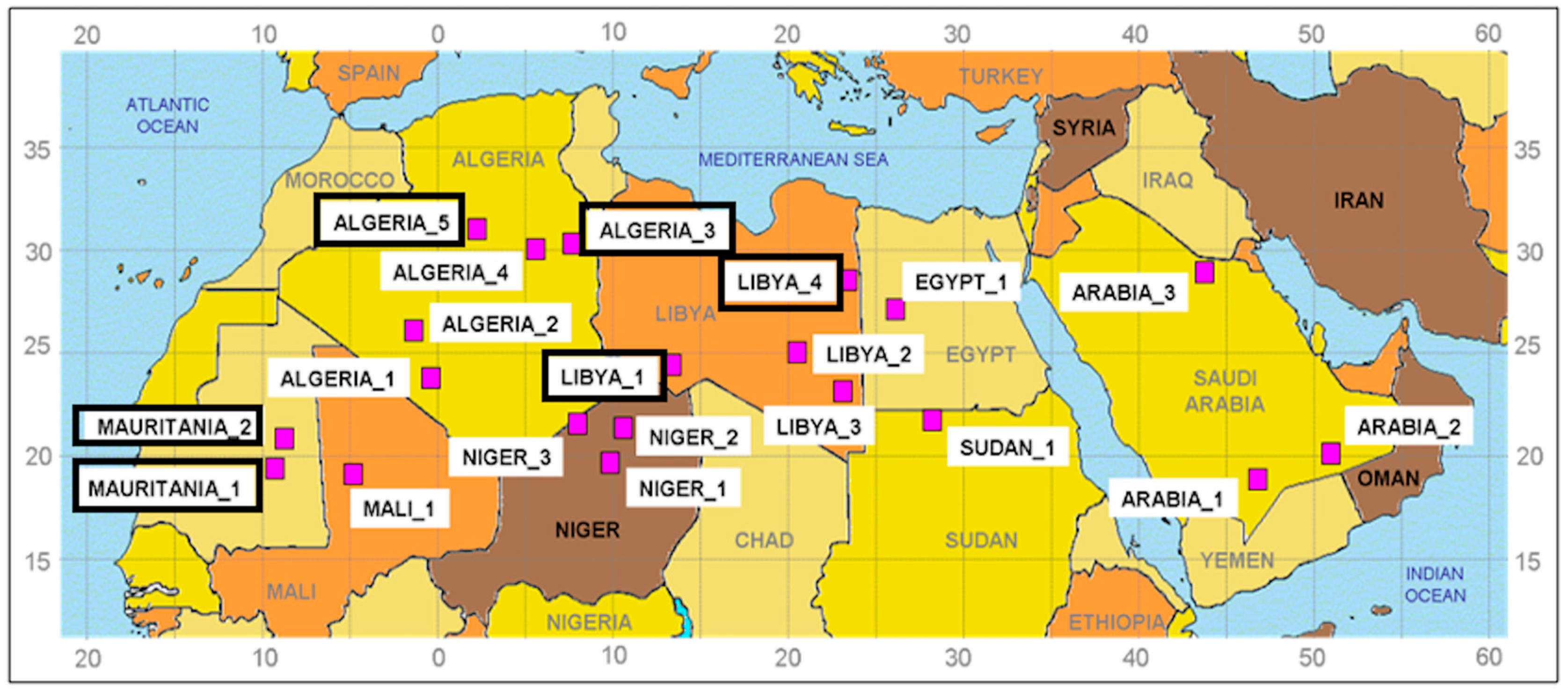

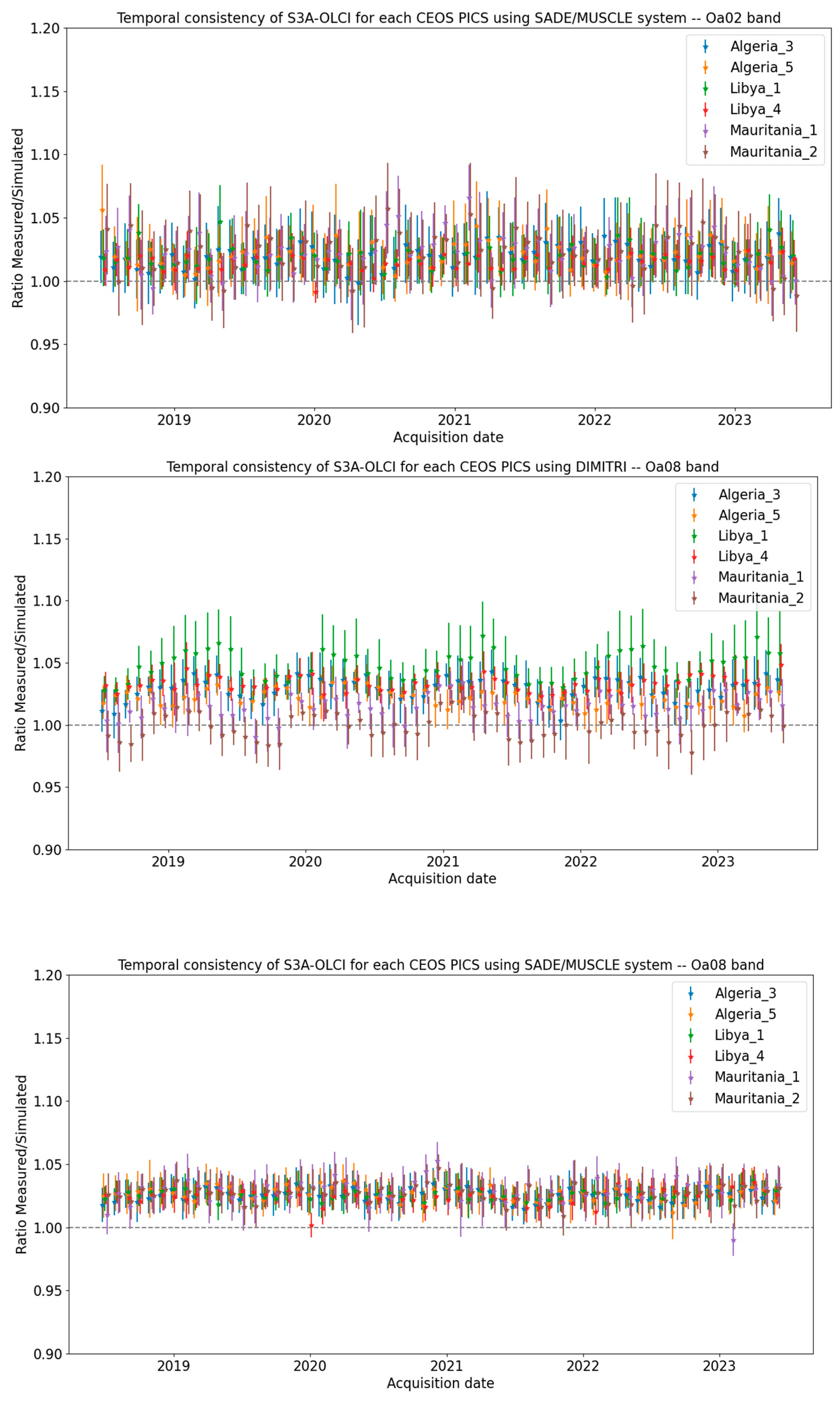
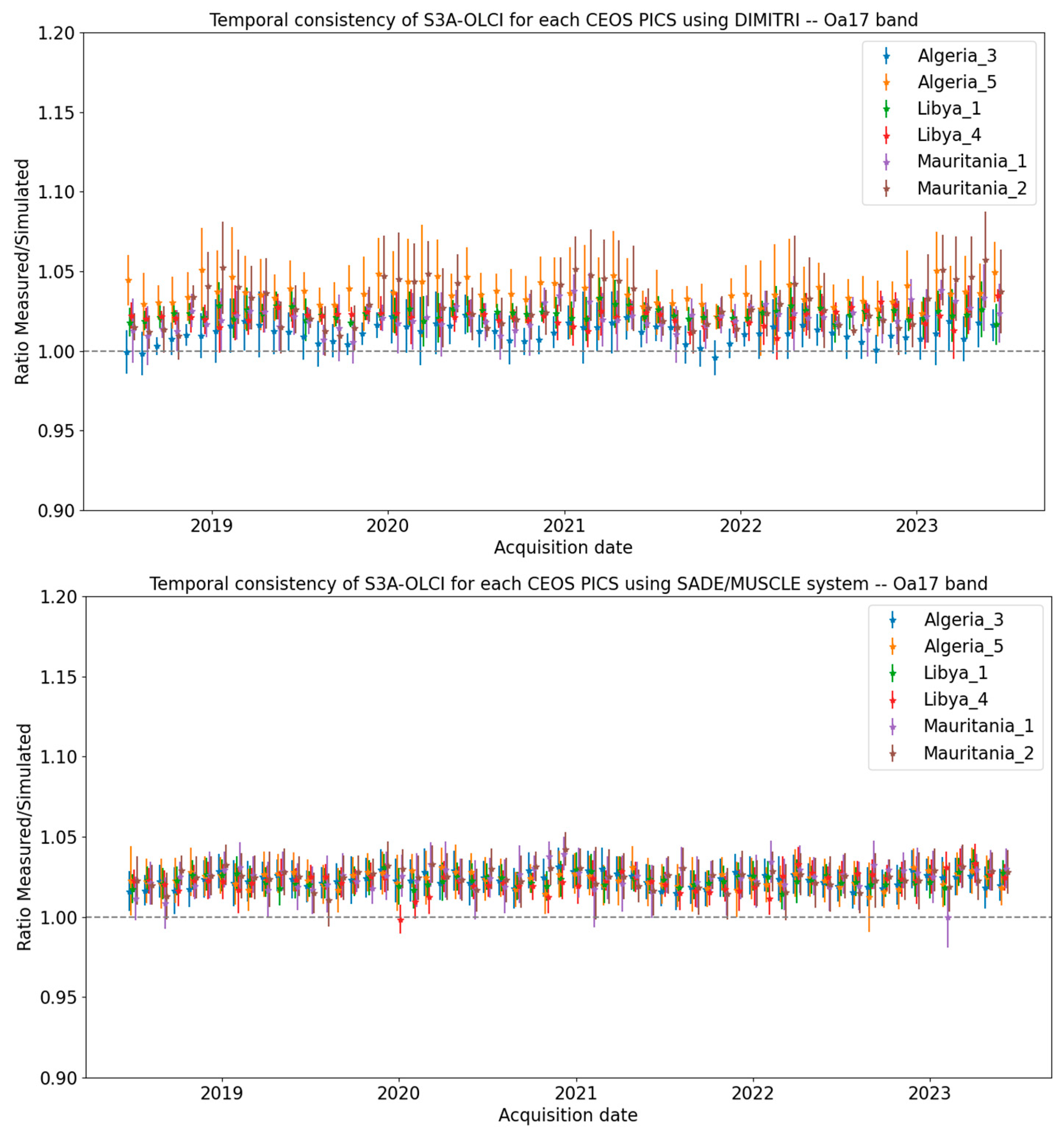
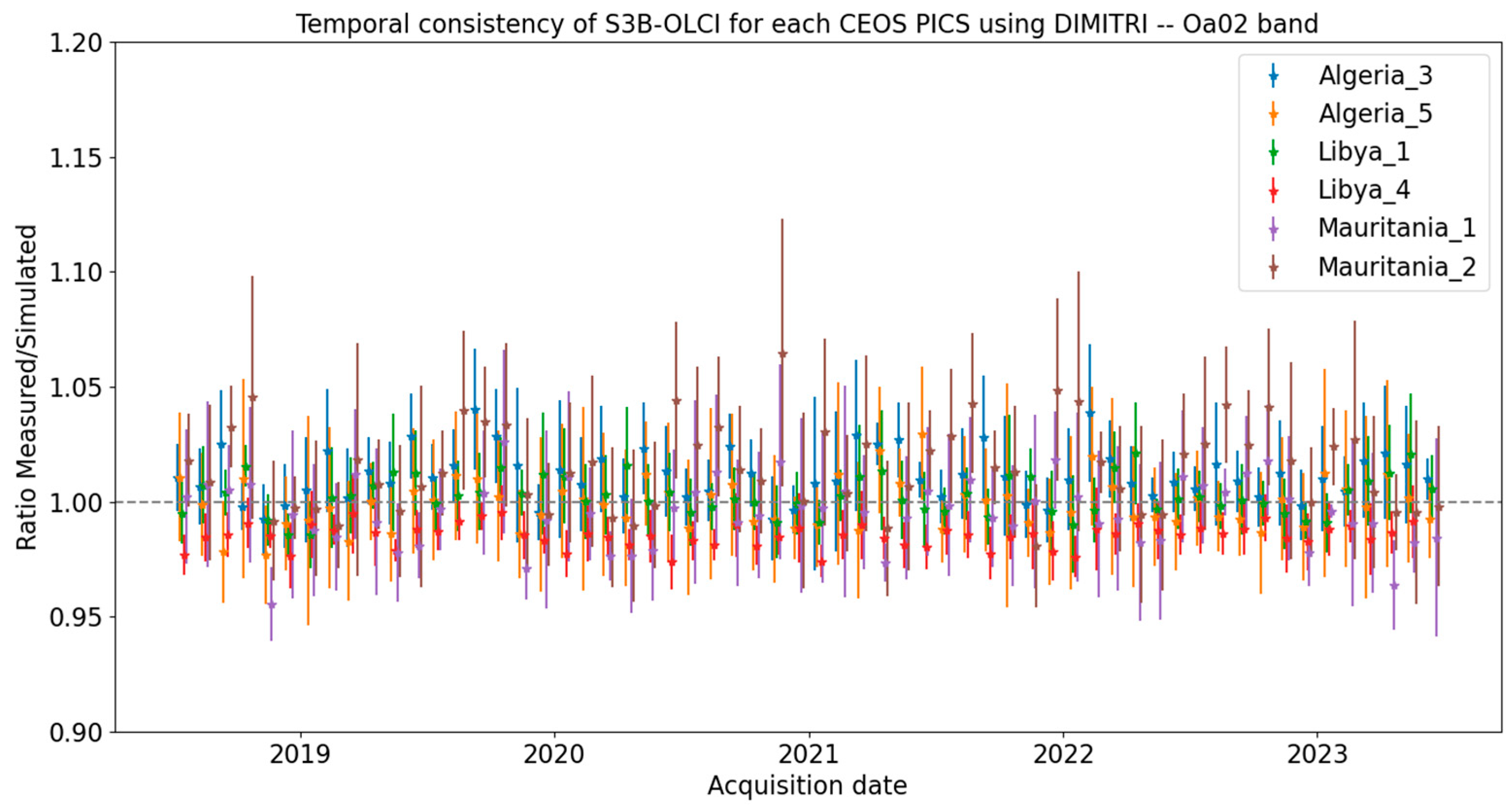

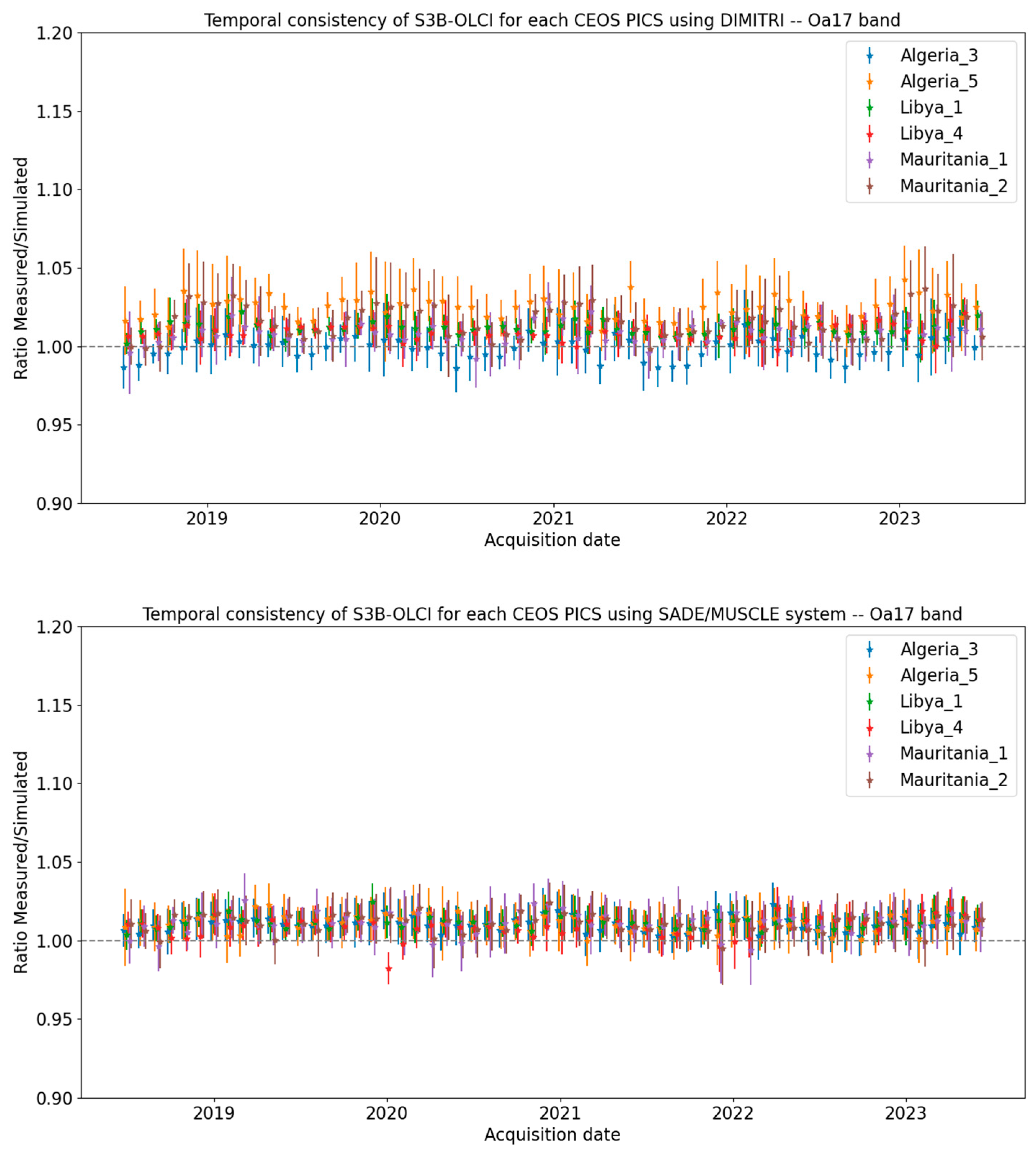


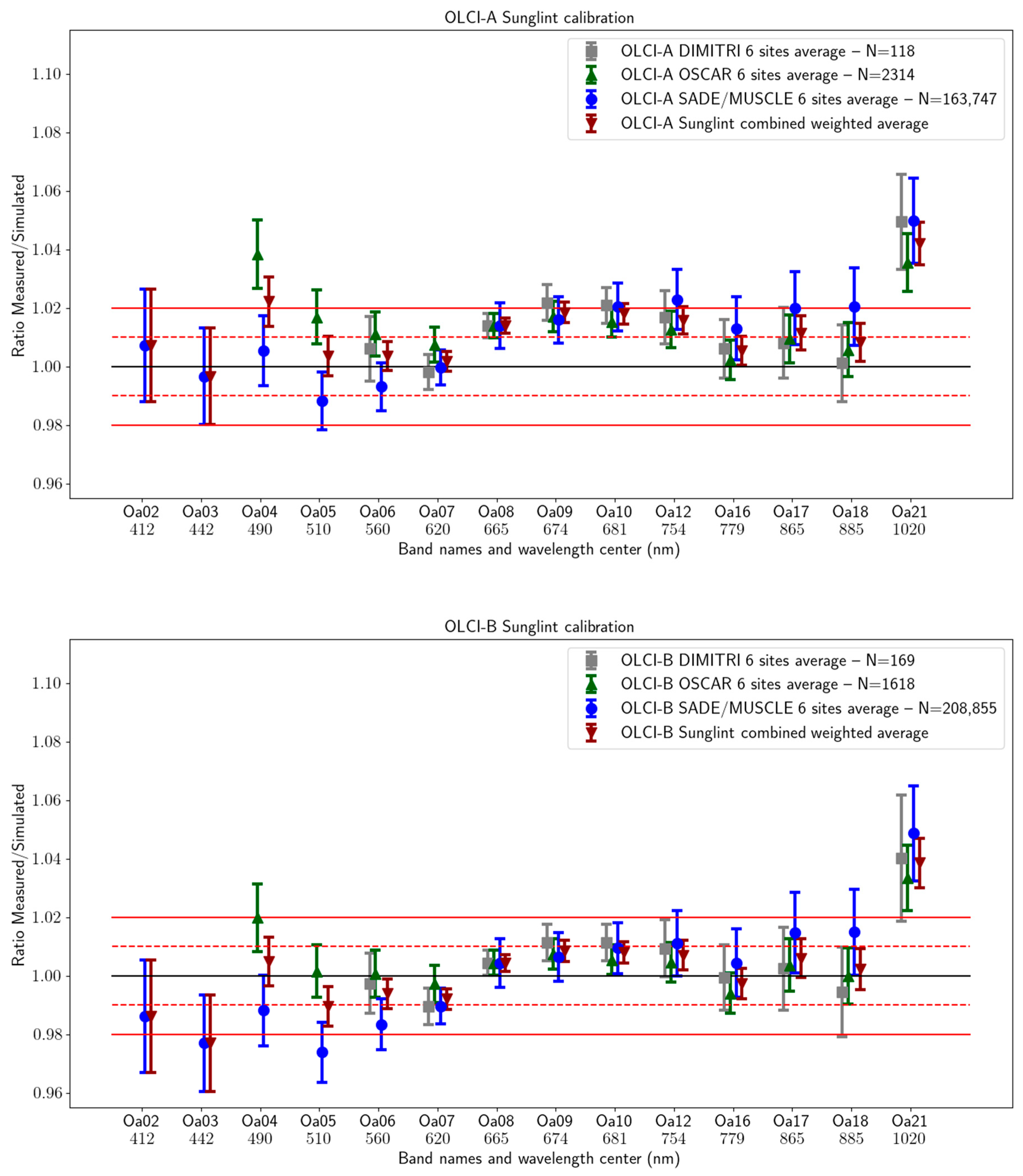
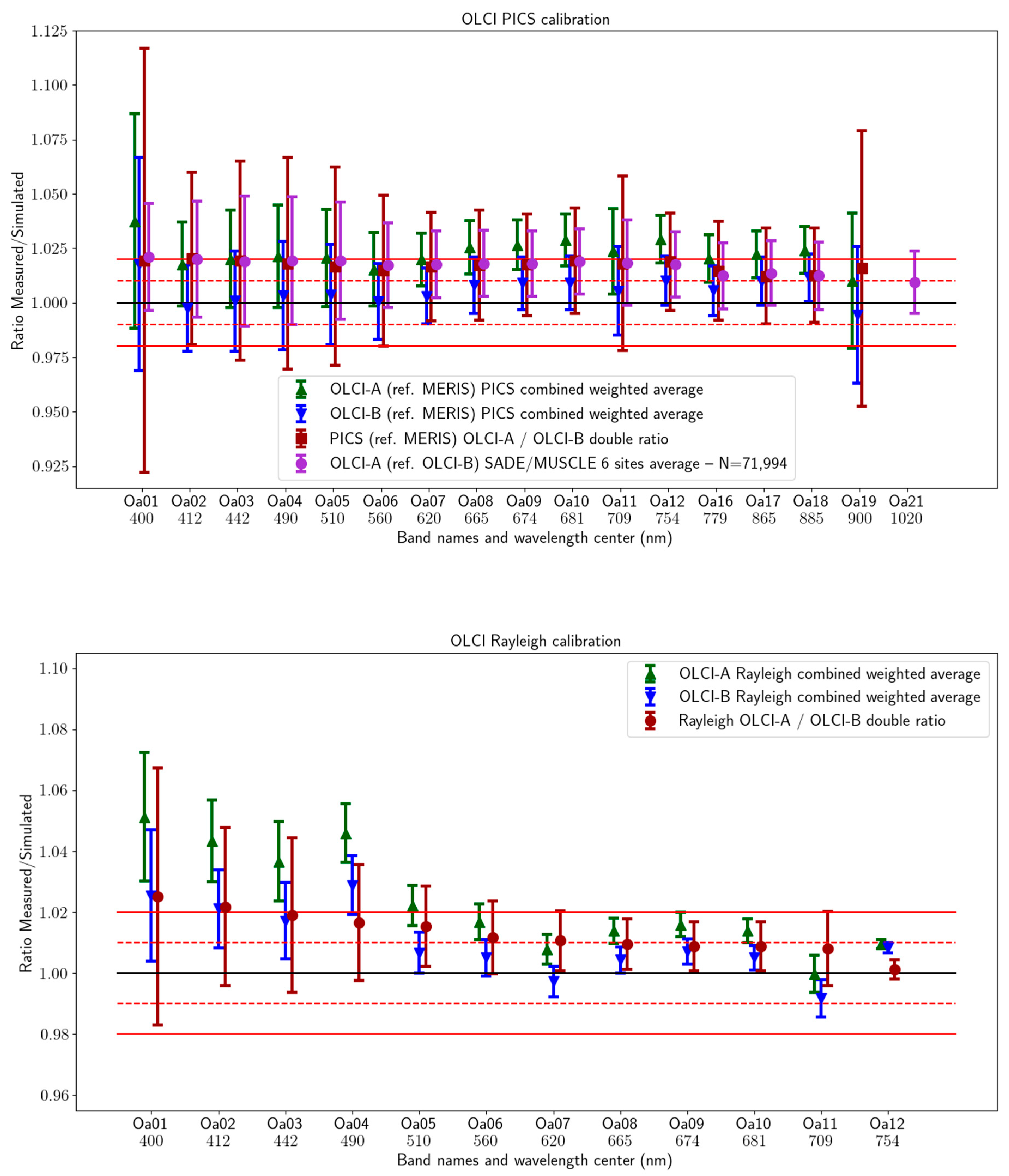

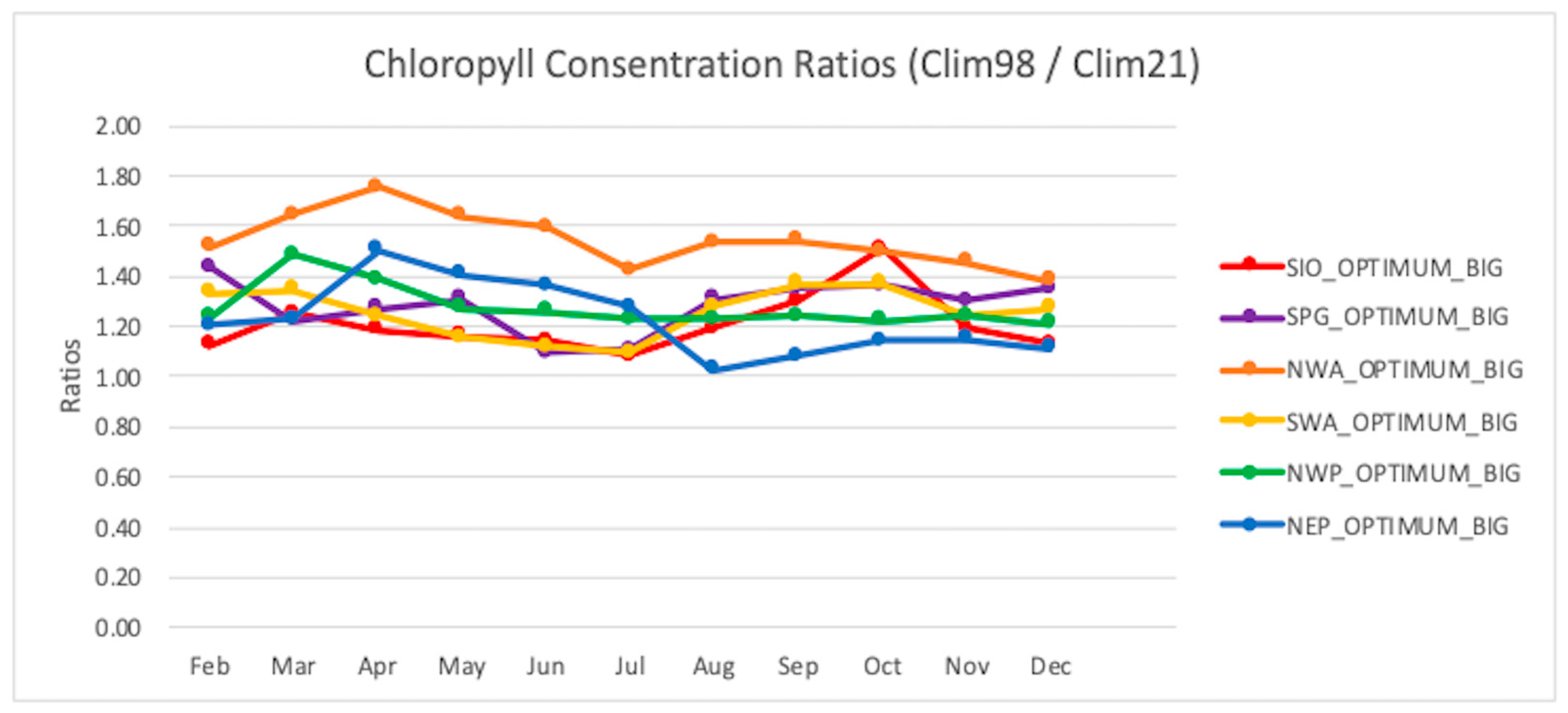
| Band | Wavelength Center (nm) | Width (nm) | Band | Wavelength Center (nm) | Width (nm) |
|---|---|---|---|---|---|
| Oa1 | 400 | 15 | Oa12 | 753.75 | 7.5 |
| Oa2 | 412.5 | 10 | Oa13 | 761.25 | 2.5 |
| Oa3 | 442.5 | 10 | Oa14 | 764.375 | 3.75 |
| Oa4 | 490 | 10 | Oa15 | 767.5 | 2.5 |
| Oa5 | 510 | 10 | Oa16 | 778.75 | 15 |
| Oa6 | 560 | 10 | Oa17 | 865 | 20 |
| Oa7 | 620 | 10 | Oa18 | 885 | 10 |
| Oa8 | 665 | 10 | Oa19 | 900 | 10 |
| Oa9 | 673.75 | 7.5 | Oa20 | 940 | 20 |
| Oa10 | 681.25 | 7.5 | Oa21 | 1020 | 40 |
| Oa11 | 708.75 | 10 |
| SW\Method | Desert-PICS | Rayleigh Scattering | Sunglint |
|---|---|---|---|
| DIMITRI | -Use BRDF model (RPV) -Use MERIS as reference sensor -Use RTM libRadtran (Monticarlo-Mystic solver) -Applicable over VNIR 400–900 nm spectral range (excludes gaseous absorption bands) -Use atmospheric conditions from L1B products (if not available, use ECMWF reanalysis) -Total uncertainty of 5%, up to 6%, at the edge of the spectral range (Oa01 and Oa19) | -Use open ocean observations with low aerosol content -Using aerosol model of [21] -Use marine model of [37] -Use LUTs from libRadtran RTM -Applicable over VIS 400–700 nm spectral range -Use monthly climatology of CHL-I concentration -Use atmospheric conditions from L1B products (if not available use ECMWF reanalysis) -Total uncertainty of 6% (blue), decreasing to 3% (red) | -Use open ocean observations with low aerosol content -Using aerosol model of [21] -Use marine model of [37] -Use LUTs from libRadtran RTM -Applicable over VIS-NIR-SWIR 500–2200 nm spectral range -Use Oa8 as reference band -Use monthly climatology of CHL-I concentration -Use atmospheric conditions from L1B products (if not available use ECMWF reanalysis) -Total uncertainty of 2.5–4% |
| SADE/MUSCLE | -Use preprocessed S3ETRAC observations -Use 20 Pseudo-Invariant Calibration Sites (focus here on 6 CEOS sites) -Cross-calibration between sensors over stable desert sites -Use several reference sensors, focus here on MERIS and OLCI -Atmospheric correction using SMAC and external meteorological data -Spectral interpolation to account for sensor differences -Applicable over VNIR to SWIR (400–2400 nm), excluding absorption bands -Total uncertainty of 2–4% for reference sensor (higher uncertainty at bluish bands) | -Use preprocessed S3ETRAC open ocean observations -Use stable oligotrophic clear-sky oceanic sites -Use SMAC for gaseous transmission and SOS for aerosol and molecular scattering -Aerosol modeling with M98 (rural + sea-salt) -Use NIR channel for AOT retrieval -Use SeaWiFS-based marine reflectance climatology-Applicable over VIS 400–700 nm spectral range -Total uncertainty of 3–6% | -Use preprocessed S3ETRAC open ocean observations -Use stable oligotrophic clear-sky oceanic sites -Use sunglint reflectance in a reference band (Oa07) to estimate wind speed -Similar radiative transfer and aerosol modeling to Rayleigh method -Applicable over VIS-NIR-SWIR 490–2400 nm spectral range -Total uncertainty of 3–5% |
| OSCAR | N/A * | -Use preprocessed S3ETRAC open ocean observations -Use marine reflectance model [19] -Use monthly Chlorophyl Climatology derived from CMEMS OLCI monthly CHL products -Use Oa16 as reference band for AOT retrieval -Apply ‘on-the-fly’ 6SV RTM simulations -Applicable over VIS 400–700 nm spectral range -Use the M98 Shettle and Fenn Maritime aerosol model -Use atmospheric conditions from S3ETRAC data -Total uncertainty of 6% (blue), decreasing to 3% (red) | -Use preprocessed S3ETRAC open ocean observations -Use marine reflectance model [19] -Use monthly Chlorophyl c Climatology derived from CMEMS OLCI monthly CHL products -Use Oa8 as reference band to derive windspeed -Apply ‘on-the-fly’ 6SV RTM simulations -Applicable over VIS-NIR-SWIR 490–2200 nm spectral range -Use atmospheric conditions from S3ETRAC data -Total uncertainty of 2–4% |
| Name | Latitude (°) | Longitude (°) | ||
|---|---|---|---|---|
| Min | Max | Min | Max | |
| Atlantic-SW-Optimum | −14.5 | −13.5 | −24.5 | −23.5 |
| Atlantic-NW-Optimum | 22.5 | 23.5 | −67.5 | −66.5 |
| Pacific-NE-Optimum | 17.5 | 18.5 | −152.5 | −151.5 |
| Pacific-NW-Optimum | 17.5 | 18.5 | 156.5 | 157.5 |
| Pacific-Southern-Gyre-Optimum | −26.5 | −25.5 | −121.5 | −119.5 |
| Southern-Indian-Ocean-Optimum | −27.5 | −26.5 | 77.8 | 78.5 |
| Band | Wavelength Center (nm) | DIMITRI Trends (%/Year) | SADE/MUSCLE Trends (%/Year) | ||
|---|---|---|---|---|---|
| OLCI-A | OLCI-B | OLCI-A | OLCI-B | ||
| Oa1 | 400 | <0.02 | −0.08 ± 0.06 | N/A * | N/A |
| Oa2 | 412.5 | 0.07 ± 0.05 | <0.03 | <0.04 | <0.01 |
| Oa3 | 442.5 | <0.03 | <0.05 | <0.01 | <0.01 |
| Oa4 | 490 | <0.03 | <0.04 | <0.04 | −0.05 ± 0.03 |
| Oa5 | 510 | <0.05 | <0.03 | <0.05 | −0.07 ± 0.03 |
| Oa6 | 560 | <0.03 | <0.05 | −0.13 ± 0.03 | −0.15 ± 0.03 |
| Oa7 | 620 | <0.04 | <0.04 | −0.11 ± 0.03 | −0.15 ± 0.02 |
| Oa8 | 665 | 0.06 ± 0.05 | <0.02 | <0.04 | −0.08 ± 0.02 |
| Oa9 | 673.75 | 0.06 ± 0.05 | <0.01 | <0.03 | −0.07 ± 0.02 |
| Oa10 | 681.25 | <0.05 | <0.01 | <0.02 | −0.07 ± 0.02 |
| Oa11 | 708.75 | <0.04 | <0.04 | <0.05 | <0.01 |
| Oa12 | 753.75 | <0.05 | <0.03 | <0.01 | <0.04 |
| Oa13 | 761.25 | N/A | N/A | N/A | N/A |
| Oa14 | 764.375 | N/A | N/A | N/A | N/A |
| Oa15 | 767.5 | N/A | N/A | N/A | N/A |
| Oa16 | 778.75 | 0.07 ± 0.05 | <0.01 | <0.01 | <0.02 |
| Oa17 | 865 | 0.05 ± 0.04 | <0.02 | <0.01 | <0.02 |
| Oa18 | 885 | <0.05 | <0.01 | <0.02 | <0.02 |
| Oa19 | 900 | N/A | N/A | N/A | N/A |
| Oa20 | 940 | N/A | N/A | N/A | N/A |
| Oa21 | 1020 | N/A | N/A | N/A | N/A |
| Band | WL Center (nm) | Desert PICS (dL) | Rayleigh (dL) | Sunglint (dL) | ALL (dL) | ||||||||
|---|---|---|---|---|---|---|---|---|---|---|---|---|---|
| Mean | SD | UNC | Mean | SD | UNC | Mean | SD | UNC | Mean | SD | UNC | ||
| Oa1 | 400 | 1.019 | 0.097 | 0.036 | 1.025 | 0.042 | 0.031 | N/A * | N/A | N/A | 1.024 | 0.039 | 0.024 |
| Oa2 | 412.5 | 1.020 | 0.040 | 0.032 | 1.022 | 0.026 | 0.031 | 1.021 | 0.039 | 0.030 | 1.021 | 0.019 | 0.020 |
| Oa3 | 442.5 | 1.019 | 0.046 | 0.032 | 1.019 | 0.025 | 0.027 | 1.020 | 0.034 | 0.030 | 1.019 | 0.019 | 0.018 |
| Oa4 | 490 | 1.018 | 0.049 | 0.032 | 1.017 | 0.019 | 0.028 | 1.017 | 0.017 | 0.021 | 1.017 | 0.012 | 0.016 |
| Oa5 | 510 | 1.017 | 0.045 | 0.032 | 1.015 | 0.013 | 0.029 | 1.014 | 0.014 | 0.021 | 1.015 | 0.009 | 0.017 |
| Oa6 | 560 | 1.015 | 0.035 | 0.029 | 1.012 | 0.012 | 0.025 | 1.010 | 0.010 | 0.022 | 1.011 | 0.008 | 0.014 |
| Oa7 | 620 | 1.017 | 0.025 | 0.029 | 1.011 | 0.010 | 0.026 | 1.010 | 0.007 | 0.022 | 1.010 | 0.006 | 0.015 |
| Oa8 | 665 | 1.017 | 0.025 | 0.029 | 1.010 | 0.008 | 0.024 | 1.010 | 0.006 | 0.022 | 1.010 | 0.005 | 0.014 |
| Oa9 | 673.75 | 1.018 | 0.023 | 0.029 | 1.009 | 0.008 | 0.024 | 1.010 | 0.007 | 0.022 | 1.010 | 0.005 | 0.014 |
| Oa10 | 681.25 | 1.019 | 0.024 | 0.029 | 1.009 | 0.008 | 0.024 | 1.010 | 0.007 | 0.022 | 1.010 | 0.005 | 0.014 |
| Oa11 | 708.75 | 1.018 | 0.040 | 0.029 | 1.008 | 0.012 | 0.034 | N/A | N/A | N/A | 1.009 | 0.012 | 0.022 |
| Oa12 | 753.75 | 1.019 | 0.022 | 0.029 | 1.001 | 0.003 | 0.034 | 1.009 | 0.010 | 0.022 | 1.002 | 0.003 | 0.016 |
| Oa13 | 761.25 | N/A | N/A | N/A | N/A | N/A | N/A | N/A | N/A | N/A | N/A | N/A | N/A |
| Oa14 | 764.375 | N/A | N/A | N/A | N/A | N/A | N/A | N/A | N/A | N/A | N/A | N/A | N/A |
| Oa15 | 767.5 | N/A | N/A | N/A | N/A | N/A | N/A | N/A | N/A | N/A | N/A | N/A | N/A |
| Oa16 | 778.75 | 1.015 | 0.023 | 0.027 | N/A | N/A | N/A | 1.008 | 0.010 | 0.023 | 1.009 | 0.009 | 0.018 |
| Oa17 | 865 | 1.012 | 0.022 | 0.027 | N/A | N/A | N/A | 1.006 | 0.013 | 0.023 | 1.007 | 0.011 | 0.018 |
| Oa18 | 885 | 1.013 | 0.022 | 0.027 | N/A | N/A | N/A | 1.006 | 0.014 | 0.025 | 1.008 | 0.012 | 0.019 |
| Oa19 | 900 | 1.016 | 0.063 | 0.032 | N/A | N/A | N/A | N/A | N/A | N/A | 1.016 | 0.063 | 0.032 |
| Oa20 | 940 | N/A | N/A | N/A | N/A | N/A | N/A | N/A | N/A | N/A | N/A | N/A | N/A |
| Oa21 | 1020 | N/A | N/A | N/A | N/A | N/A | N/A | 1.003 | 0.015 | 0.027 | 1.003 | 0.015 | 0.027 |
| Band | Wavelength Center (nm) | RDP (%) |
|---|---|---|
| Oa1 | 400 | 1.636 |
| Oa2 | 412.5 | 2.038 |
| Oa3 | 442.5 | 1.296 |
| Oa4 | 442 | 0.321 |
| Oa5 | 510 | −0.163 |
| Oa6 | 560 | −0.166 |
| Oa7 | 620 | −0.141 |
| Oa8 | 665 | −0.114 |
| Oa9 | 673.75 | −0.136 |
Disclaimer/Publisher’s Note: The statements, opinions and data contained in all publications are solely those of the individual author(s) and contributor(s) and not of MDPI and/or the editor(s). MDPI and/or the editor(s) disclaim responsibility for any injury to people or property resulting from any ideas, methods, instructions or products referred to in the content. |
© 2025 by the authors. Licensee MDPI, Basel, Switzerland. This article is an open access article distributed under the terms and conditions of the Creative Commons Attribution (CC BY) license (https://creativecommons.org/licenses/by/4.0/).
Share and Cite
Alhammoud, B.; Desjardins, C.; Sterckx, S.; Adriaensen, S.; Mackenzie, C.; Bourg, L.; Clerc, S.; Dransfeld, S. Copernicus Sentinel-3 OLCI Level-1B Radiometry Product Validation Status After Six Years in Constellation by Three Independent Expert Groups. Remote Sens. 2025, 17, 1217. https://doi.org/10.3390/rs17071217
Alhammoud B, Desjardins C, Sterckx S, Adriaensen S, Mackenzie C, Bourg L, Clerc S, Dransfeld S. Copernicus Sentinel-3 OLCI Level-1B Radiometry Product Validation Status After Six Years in Constellation by Three Independent Expert Groups. Remote Sensing. 2025; 17(7):1217. https://doi.org/10.3390/rs17071217
Chicago/Turabian StyleAlhammoud, Bahjat, Camille Desjardins, Sindy Sterckx, Stefan Adriaensen, Cameron Mackenzie, Ludovic Bourg, Sebastien Clerc, and Steffen Dransfeld. 2025. "Copernicus Sentinel-3 OLCI Level-1B Radiometry Product Validation Status After Six Years in Constellation by Three Independent Expert Groups" Remote Sensing 17, no. 7: 1217. https://doi.org/10.3390/rs17071217
APA StyleAlhammoud, B., Desjardins, C., Sterckx, S., Adriaensen, S., Mackenzie, C., Bourg, L., Clerc, S., & Dransfeld, S. (2025). Copernicus Sentinel-3 OLCI Level-1B Radiometry Product Validation Status After Six Years in Constellation by Three Independent Expert Groups. Remote Sensing, 17(7), 1217. https://doi.org/10.3390/rs17071217











